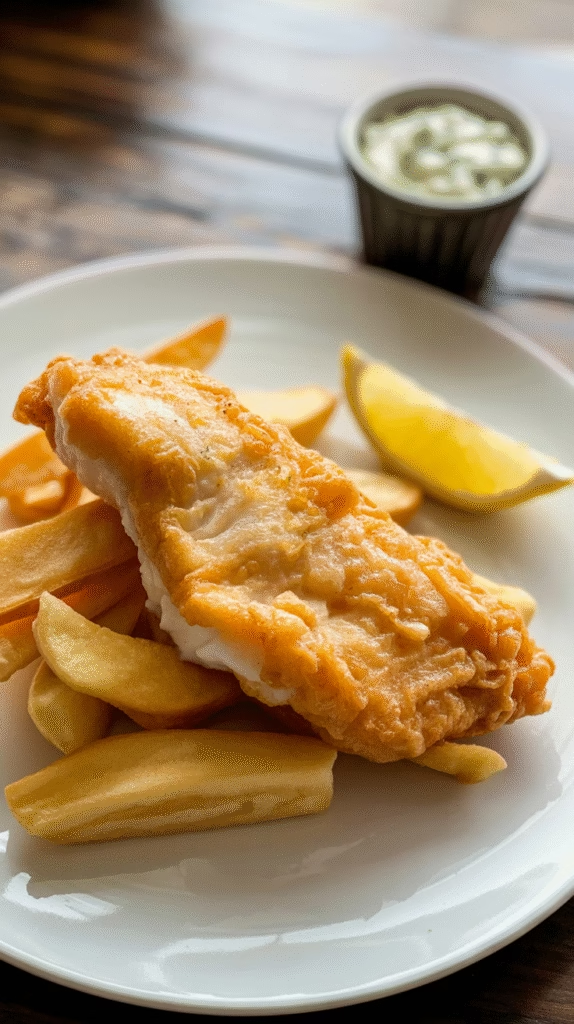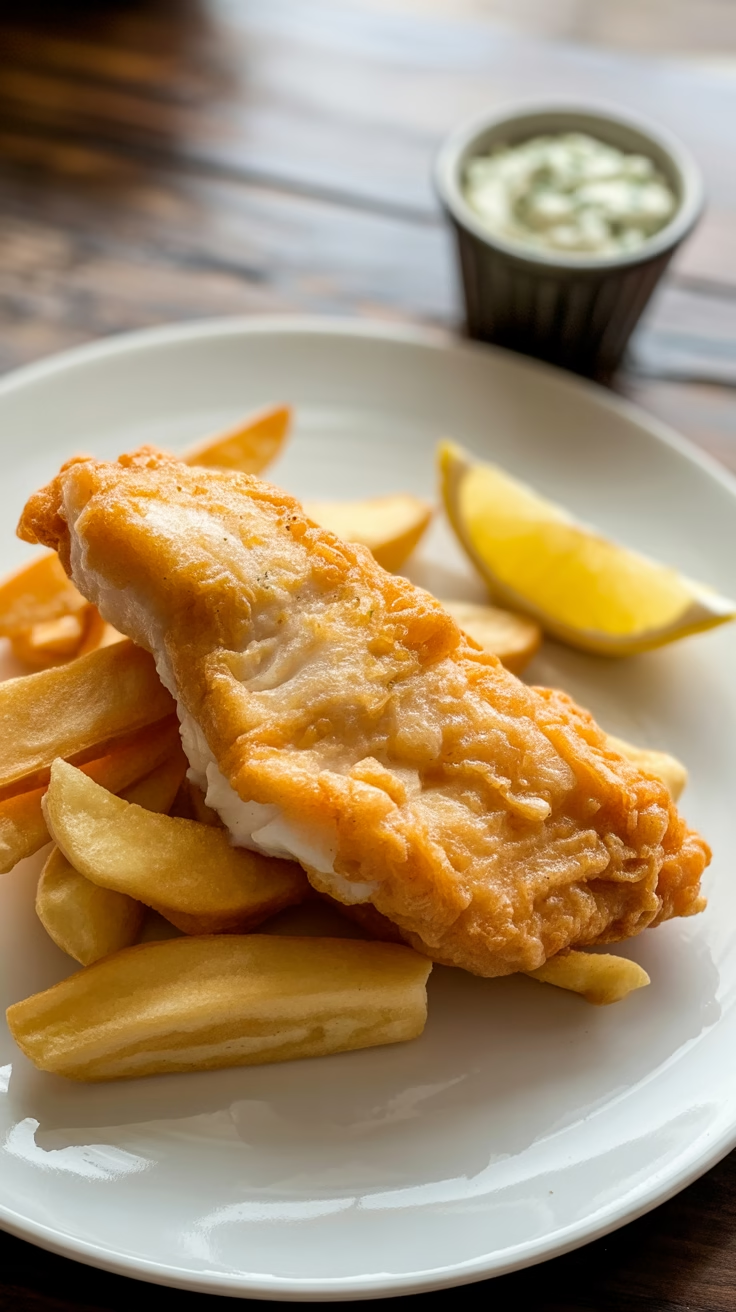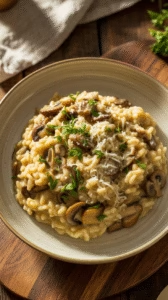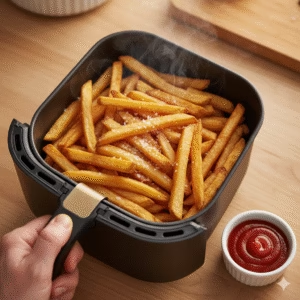You know that craving that hits you at 2 PM on a random Tuesday? The one where you’re practically drooling over the thought of crispy, golden fish wrapped in newspaper? Well, forget the takeaway queue, we’re making restaurant,quality fish and chips right in your kitchen.
I spent way too many Friday nights perfecting this recipe, but here’s the thing: once you master this, you’ll never look at frozen fish fingers the same way again. This isn’t just another recipe, it’s your ticket to becoming the hero of family dinners.
Perfect Batter Every Time
What Makes Batter Actually Crispy
Here’s what nobody tells you about batter: it’s not just flour and water thrown together. The magic happens when you get the texture and temperature combo just right.
My go-to mix uses self-raising flour as the base; it gives you that lovely lift without needing extra agents. Then I add cornflour (about 25% of the total flour weight) because it’s basically the superhero of crispiness.
But here’s where it gets interesting: instead of plain water, I use ice-cold sparkling water or beer. The bubbles create tiny air pockets that puff up in the hot oil, giving you that satisfying crunch. Room temperature liquids? Nah, they’ll give you soggy disappointment.
The Consistency Sweet Spot
Your batter should coat the back of a spoon but still drip off easily. Think thick cream consistency,not pancake batter thick, but definitely not watery either. If you can draw a line through it with your finger and it holds for a second before flowing back, you’ve nailed it.
Fish Selection: Don’t Mess This Up
The Champions of Fish and Chips
Look, you can’t just grab any random fish from the freezer section and expect miracles. You need firm, white fish that won’t disintegrate the moment it hits the oil.
My top picks:
- Cod: The undisputed champion—mild, flaky, holds together beautifully
- Haddock: Slightly more flavor than cod, equally reliable
- Pollock: Budget-friendly option that still delivers
- Halibut: If you’re feeling fancy and your wallet can handle it
Avoid: Anything too delicate (sole, plaice) or oily (salmon, mackerel). Save those for other recipes.
Fresh vs. Frozen: The Truth
Fresh fish is obviously ideal, but frozen isn’t the enemy here. Just make sure you thaw it properly—overnight in the fridge, not in warm water. Pat it completely dry before battering, or you’ll get that dreaded soggy coating.
Chip Perfection: It’s All About Technique
The Right Potato Makes All the Difference
Not all potatoes work for chips. You want high-starch varieties like Maris Piper, King Edward, or Russet. These have less moisture and more starch, which means fluffier insides and crispier outsides.
Waxy potatoes like Charlotte or new potatoes? Save them for salads. They’ll give you dense, gummy chips that nobody wants.
The Double-Fry Method
Here’s where most home cooks go wrong: they try to do everything in one go. Professional chippies use a two-stage frying process, and there’s a reason for it.
First fry (325°F/165°C): This cooks the potato through without browning. About 4-5 minutes.
Second fry (375°F/190°C): This creates the golden, crispy exterior. Another 2-3 minutes.
Yes, it’s more work, but the difference is night and day. Your chips will be fluffy inside, crispy outside, and absolutely irresistible.

The Complete Recipe Breakdown
Ingredients You’ll Actually Need
For the Fish:
- 4 thick white fish fillets (about 6oz each)
- 200g self-raising flour
- 50g cornflour
- 300ml ice-cold sparkling water or beer
- 1 tsp salt
- Oil for deep frying
For the Chips:
- 4 large potatoes (about 2lbs)
- Oil for deep frying
- Salt to taste
Step-by-Step Method
Prep Your Chips First:
- Peel and cut potatoes into chunky chips (about 1cm thick)
- Rinse in cold water until the water runs clear
- Pat completely dry with kitchen towels
- First fry at 325°F for 4-5 minutes
- Drain on paper towels
Make Your Batter:
- Mix flours and salt in a bowl
- Gradually whisk in cold sparkling water until smooth
- Let it rest for 10 minutes (this helps the flour hydrate)
Fry the Fish:
- Heat oil to 350°F
- Pat fish dry and season with salt
- Dip in batter, letting excess drip off
- Fry for 4-5 minutes until golden
- Drain on paper towels
Finish the Chips:
- Second fry at 375°F for 2-3 minutes until golden
- Season immediately with salt
Pro Tips That Actually Matter
Temperature Control is Non-Negotiable
Invest in a decent thermometer. Guessing oil temperature is like playing Russian roulette with your dinner. Too hot burns the outside, too cool makes everything greasy.
The Resting Game
Let your batter rest for 10 minutes before using. This isn’t just fancy chef nonsense; it actually improves the texture. The flour fully hydrates, giving you smoother, more cohesive batter.
Timing is Everything
Fry your chips first, then keep them warm in a low oven (200°F) while you do the fish. This way, everything’s ready at the same time, and your chips stay crispy.
Common Mistakes (And How to Avoid Them)
The Soggy Batter Disaster
This usually happens because your oil wasn’t hot enough or your batter was too thick. Test your oil with a drop of batter—it should sizzle immediately and float to the surface.
Greasy Results
If your fish and chips taste like they’ve been swimming in oil, your temperature was too low. Hot oil seals the outside quickly, preventing oil absorption.
Falling Apart Fish
This happens when you move the fish too soon after dropping it in the oil. Give it 30 seconds to set before even thinking about touching it.
Serving Like a Pro
The Classic Accompaniments
Traditional fish and chips come with mushy peas and tartare sauce. But honestly? A squeeze of fresh lemon and some malt vinegar work just as well.
For mushy peas, just simmer frozen peas with a bit of butter and mint until they break down. Season with salt and pepper.
Presentation Matters
Serve immediately on warm plates. If you want to go traditional, wrap in newspaper (make sure it’s food-safe) or parchment paper. The steam helps keep everything warm and creates that authentic chippy experience.

Troubleshooting Your Results
Batter Won’t Stick
Your fish might be too wet. Pat it bone dry and even dust with a little flour before dipping in batter.
Chips Aren’t Crispy
You probably skipped the double-fry method or your oil temperature was off. There’s no shortcut to perfect chips,follow the process.
Oil Keeps Foaming
This happens when you add wet food to hot oil. Make sure everything’s properly dried, and don’t overcrowd the pan.
Making It Your Own
Flavor Variations
Once you’ve mastered the basic recipe, try these twists:
- Add paprika to your batter for a subtle smoky flavor
- Use beer instead of sparkling water for extra depth
- Season your flour with garlic powder or dried herbs
Different Fish, Same Method
This technique works with any firm white fish. Adjust cooking times based on thickness, but the method stays the same.
The Final Word
Making perfect fish and chips isn’t rocket science, but it does require attention to detail. The difference between good and great comes down to temperature control, timing, and technique.
Will your first batch be perfect? Probably not—mine certainly wasn’t 🙂 But stick with it, and you’ll be turning out chippy-quality fish and chips that’ll make you wonder why you ever bothered with takeaway.
Remember: hot oil, cold batter, dry ingredients, and patience. Get these right, and you’re golden. Literally.
Now stop reading and start frying—your kitchen’s about to smell absolutely incredible, and your taste buds are in for a treat. IMO, there’s no better way to spend a weekend afternoon than perfecting this British classic.
Fish and Chips Recipe: Your Kitchen’s About to Smell Amazing
Course: MainCuisine: BritishDifficulty: Medium4
servings20
minutes25
minutes650
kcal45
minutesClassic British fish and chips with golden, crispy batter and perfectly fluffy chips. This recipe uses a double-fry method for restaurant-quality results at home. The secret lies in ice-cold sparkling water batter and proper oil temperature control for that signature crunch.
Ingredients
For the Fish:
4 thick white fish fillets (6oz each) – cod, haddock, or pollock
200g self-raising flour
50g cornflour
300ml ice-cold sparkling water or beer
1 tsp salt
Oil for deep frying
- For the Chips:
4 large potatoes (2lbs) – Maris Piper or Russet
Oil for deep frying
Salt to taste
- To Serve:
Lemon wedges
Malt vinegar
Tartare sauce
Mushy peas (optional)
Directions
Prep the Chips:
- Peel and cut potatoes into 1cm thick chips
- Rinse in cold water until water runs clear
- Pat completely dry with kitchen towels
- First fry: 325°F (165°C) for 4-5 minutes
- Drain on paper towels and set aside
- Make the Batter:
- Mix self-raising flour, cornflour, and salt in a bowl
- Gradually whisk in ice-cold sparkling water until smooth
- Let rest for 10 minutes (consistency should coat spoon but drip off easily)
- Fry the Fish:
- Heat oil to 350°F (175°C)
- Pat fish dry and season with salt
- Dip in batter, letting excess drip off
- Fry for 4-5 minutes until golden brown
- Drain on paper towels
- Finish the Chips:
- Second fry: 375°F (190°C) for 2-3 minutes until golden
- Season immediately with salt
Notes
- Temperature is crucial: Use a thermometer – don’t guess
Double-fry method: Essential for crispy chips
Batter consistency: Should coat spoon but still drip off
Timing: Fry chips first, keep warm in 200°F oven while frying fish
Don’t overcrowd: Fry in batches if necessary




